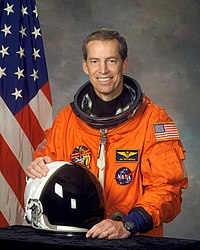Jim Wetherbee
| James Wetherbee | |
|---|---|

|
|
| Country: | United States |
| Organization: | NASA |
| selected on | May 23, 1984 (10th NASA Group) |
| Calls: | 6 space flights |
| Start of the first space flight: |
January 9, 1990 |
| Landing of the last space flight: |
December 7, 2002 |
| Time in space: | 66d 10h 23m |
| retired on | January 2005 |
| Space flights | |
James Donald Wetherbee (born November 27, 1952 in Flushing , Queens , New York City , USA ) is a former American astronaut .
Wetherbee was born in Flushing, but grew up 60 kilometers away in the small town of Huntington Station, where his parents still live today. After a Catholic high school, he attended the Catholic University of Notre Dame in Indiana . There he studied aerospace engineering and received a bachelor's degree in 1974 . (US Secretary of State Condoleezza Rice was enrolled in Notre Dame University at the same time).
Immediately after graduating, Wetherbee entered the US Navy , where he made a career as a naval aviator. After training as a pilot, he served three years on the aircraft carrier " USS John F. Kennedy " to be him in 1980 at the United States Naval Test Pilot School in Patuxent River ( Maryland ) for test pilots trained. He then held various managerial positions in the further development of the F / A-18 "Hornet" fighter aircraft . In early 1984 he came to the 132nd Combat Squadron at Naval Air Station Lemoore in California , where he worked as an astronaut until he was hired.
Astronaut activity
Wetherbee joined NASA in May 1984 as a candidate astronaut. He had always wanted to take up this profession, but was aware that the probability would be very small. Although he was very comfortable in the Navy, his desire to become an astronaut was always in the back of his mind. It was his wife who encouraged him to apply to NASA. He was a test pilot when he finally submitted his documents and was accepted on his first try.
After completing basic training in June 1985 until the Challenger disaster in January 1986, he worked as a CapCom in the Mission Control Center.
His first appointment for a space shuttle mission was in November 1988 as a pilot of STS-32 . The aim of the flight in January 1990 was, in addition to deploying a communications satellite from the Intelsat series, to capture the LDEF research platform, which had spent almost six years in space.
Initially appointed as a pilot for STS-46 , Wetherbee was given its first own command in the fall of 1991: STS-52 in October 1992 with the space shuttle Columbia launched the Italian-American satellite LAGEOS-2 . Three microgravity experiments from the USA and France were also carried out on board as part of the “United States Microgravity Payload (USMP-1)”.
Just a year after STS-52, Wetherbee was set up for its third mission. STS-63 made space history at the beginning of February 1995 when the crew around Commander Wetherbee carried out the first rendezvous of a US space shuttle (with pilot Eileen Collins for the first time controlled by a woman) with the Russian station Mir .
In the fall of 1997, Wetherbee led the STS-86 mission . It was the ninth flight in the Shuttle-Mir program , which had the seventh coupling of a shuttle to the Mir station as its destination. The Atlantis ferry brought supplies and the replacement for Michael Foale to the space station. Astronaut Foale had worked on board since May and has now been replaced by David Wolf .
Until his next space flight, Wetherbee worked in administration: since the fall of 1995, he was deputy director of the Johnson Space Center (JSC) for five years .
Wetherbee's fifth flight was in March 2001 as the commander of STS-102 . The Discovery brought equipment and a fresh crew to the International Space Station (ISS) under construction . For this purpose, the Leonardo module , which contained the majority of the payloads to be delivered, was located in the cargo hold of the orbiter . The shuttle crew brought the 2nd regular crew to the ISS and picked up the 1st crew again after 140 days of service.
When Wetherbee took off on its last space flight with STS-113 in late 2002 , he was the first astronaut to lead five missions. The Endeavor brought the P1 carrier to the ISS. With three exits, the 12-ton structure was attached to the space station. In addition, the dissolved 6. ISS crew , the Expedition 5 from.
Jim Wetherbee resigned from the US Navy in 2003 and left NASA in early 2005. He and his wife Robin have two daughters.
See also
Web links
- Short biography of Jim Wetherbee at spacefacts.de
- NASA biography of Jim Wetherbee (English; PDF)
- Biography of Jim Wetherbee in the Encyclopedia Astronautica (English)
| personal data | |
|---|---|
| SURNAME | Wetherbee, Jim |
| ALTERNATIVE NAMES | Wetherbee, James Donald (full name) |
| BRIEF DESCRIPTION | American astronaut |
| DATE OF BIRTH | November 27, 1952 |
| PLACE OF BIRTH | New York City , USA |